We may not have the course you’re looking for. If you enquire or give us a call on +47 80010068 and speak to our training experts, we may still be able to help with your training requirements.
Training Outcomes Within Your Budget!
We ensure quality, budget-alignment, and timely delivery by our expert instructors.
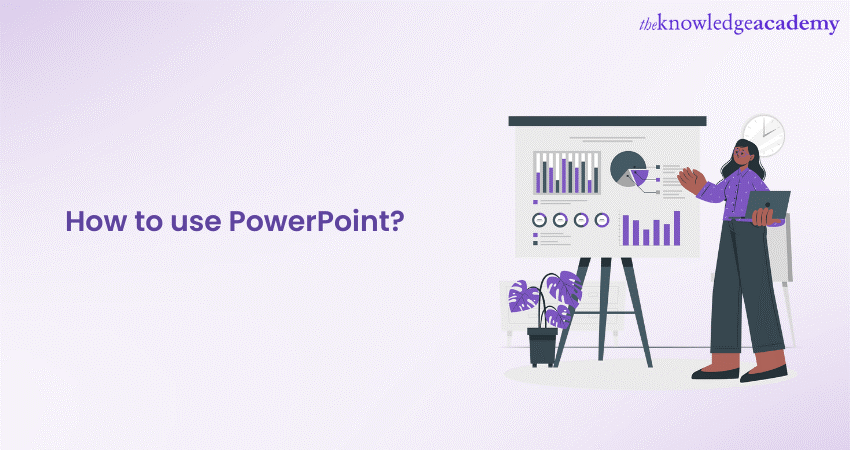
Are you a beginner looking to create your first presentation? Or are you seeking to enhance your existing presentation skills? If yes, then learning How to Use PowerPoint can prove to be a game changer.
Today, in educational institutions, professional meetings, or even for personal projects, PowerPoint has become a powerful platform for creating visually captivating and engaging presentations.
So, if you wish to enhance your presentation abilities and engage, inspire, and captivate your audience, you have come to the right place. Read this blog to learn How to Use PowerPoint. Also, explore the essential steps and techniques for harnessing the full potential of this platform.
Table of Contents
1) Introduction: How to Create a PowerPoint Presentation?
2) How to use Microsoft PowerPoint?
a) Working with slides
b) Adding content to slides
c) Inserting images and graphics
d) Adding charts and tables
e) SmartArt and shapes
f) Apply themes and templates
2) Tips and tricks for a great presentation
3) Conclusion
Introduction: How to Create a PowerPoint Presentation?
PowerPoint is a versatile tool with a vast array of uses. It can serve as an aid in corporate training sessions, act as a resource for educators in the classroom, bring attention to significant historical occurrences, or present complex statistical information in an accessible format.
As a medium for instruction, dissemination, and education, slide presentations are invaluable. They are instrumental in conveying concepts clearly and effectively to an audience, regardless of the subject matter. PowerPoint presentations streamline the process of sharing knowledge and ideas, making them an indispensable asset in both academic and professional settings.
How to use Microsoft PowerPoint?
Microsoft PowerPoint is a widely used application that enables you to create attractive and engaging presentations. Several tools and PowerPoint features allow you to make presentations that are both powerful and engaging.
So, embark on the journey to learn How to use PowerPoint for beginners and create impressive presentations. Follow the steps mentioned below:
Working with slides
Slides are the building blocks of your PowerPoint Presentation. They provide a structured format for presenting your ideas, visuals, and information. Let's learn how to work with slides effectively in PowerPoint.
Step 1: Adding slides
To add a new slide to your presentation, follow these steps:
a) Go to the "Home" tab in the Ribbon and click on the "New Slide" button
b) A gallery of slide layouts will appear, offering various options for structuring your content
c) Choose the layout that best suits your requirements
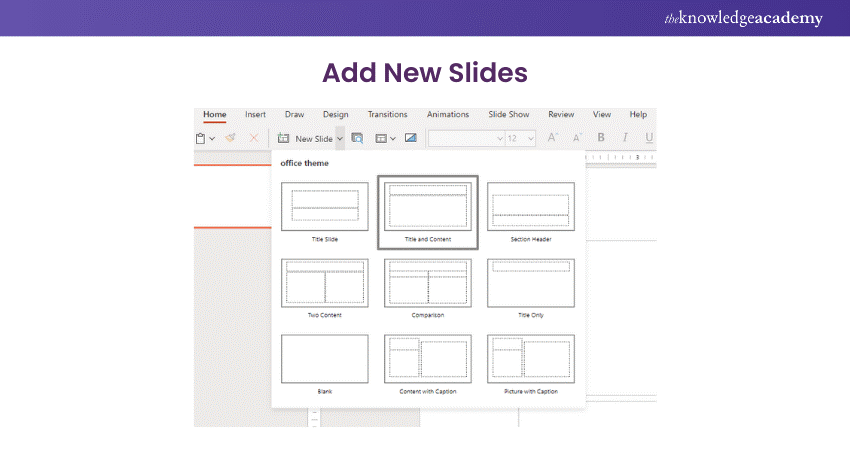
Take your Microsoft Office skills to the next level – sign up for our Power Apps and Power Automate Training!
Step 2: Duplicating and deleting slides
When you want to create a similar slide to one you’ve already created, it’s convenient to duplicate it. You will need to do the following:
a) Select the slide you want to duplicate
b) Right-click and choose the “Duplicate Slide” option
c) A copy of the slide will appear right after the original one
If you no longer need a slide, select it. Then, press the “Delete” key on the keyboard, or right-click on it and choose “Delete Slide.”
Note: Be cautious when deleting slides, as this action cannot be undone.
Step 3: Hide slides
There may be instances when you want to hide certain slides during your presentation temporarily. To do this:
a) Select the slide(s) you want to hide
b) Right-click on them and choose "Hide Slide" from the context menu
The hidden slides will not be visible during your presentation but can still be accessed for editing purposes.
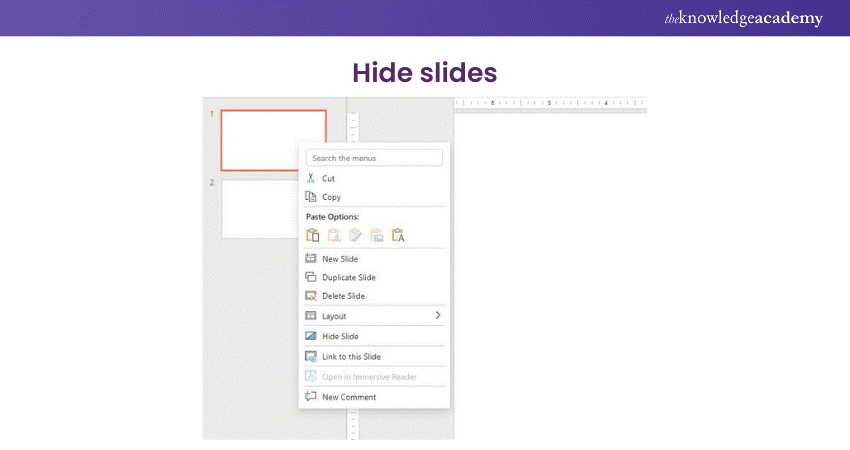
Step 4: Sections
PowerPoint allows you to organise your presentation into sections, making navigating and managing larger presentations easier. To create a section, follow these steps:
a) Go to the "Home" tab
b) Click on the "Section" button in the "Slides" group
c) Choose "Add Section"
d) Provide a name for the section
e) Right-click on a slide and choose "Move to Section" to organise your slides effectively

Adding content to slides
After learning How to Use Microsoft PowerPoint slides, it’s time to move towards adding content to your selected layout. You can add content to your Powerpoint slides in the following ways:
Step 1: Inserting text
To add text to a slide, follow these steps:
a) Select the slide and click on a text box or placeholder
b) Start typing to enter your content
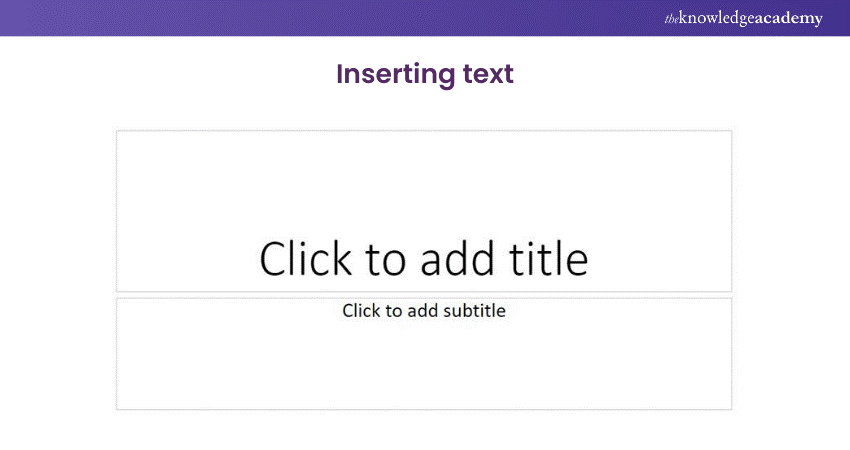
Step 2: Formatting text
PowerPoint offers various formatting options to enhance the visual appeal of your text. You can do the following:
a) Select the text you want to format
b) Use the formatting tools in the "Home" tab of the Ribbon
Experiment with various font styles, sizes, and colours to find the right combination that complements your presentation's theme.
Inserting images and graphics
Visuals play a crucial role in capturing the attention of your audience. To insert an image or graphic, follow the given steps:
a) Go to the "Insert" tab in the Ribbon
b) Click on the "Pictures" or "Online Pictures" button
c) Select the desired image from your computer or search for images online
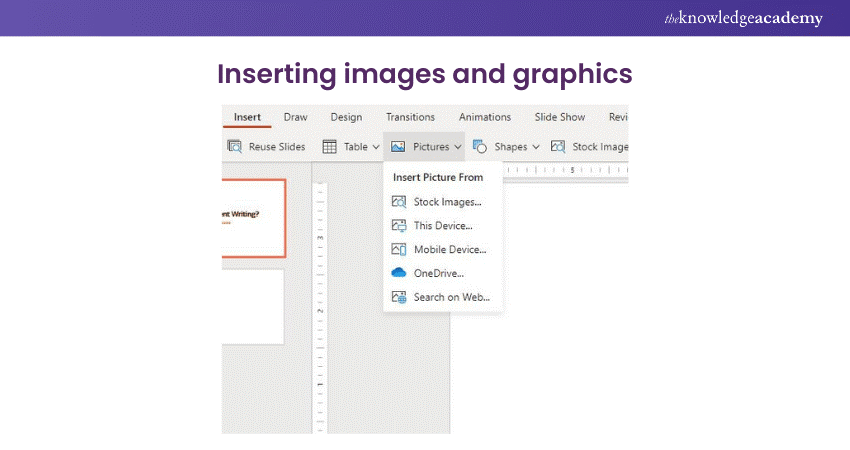
PowerPoint allows you to resize, crop, and adjust the position of images to fit your slide’s layout. Consider using high-quality visuals that enhance the understanding of your content. The new designer tab will give you more options to enhance your slides visually and make them appealing.
Adding charts and tables
Data-driven presentations often require charts and tables to present information clearly and in order. PowerPoint provides a range of pre-designed charts and tables to insert into your slides. You can add charts and tables by following the given steps:
a) Go to the "Insert" tab
b) Click on the "Chart" or "Table" button
c) Choose the appropriate chart or table type and enter your data
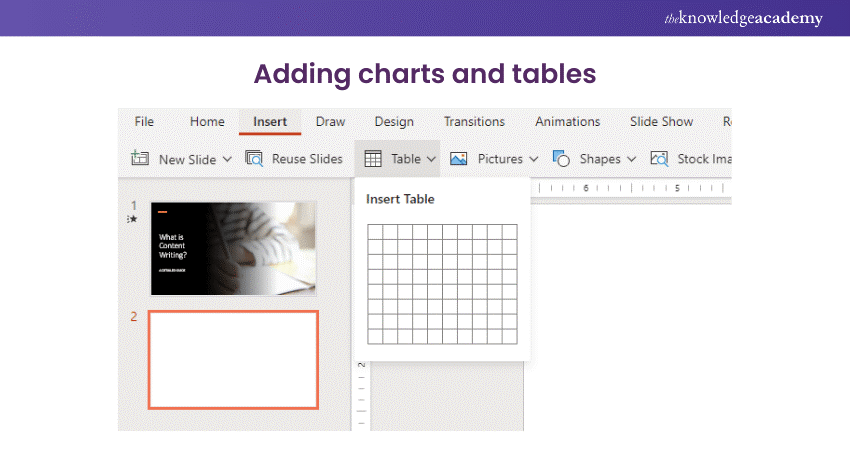
You can also customise the appearance and formatting of charts and tables to suit your presentation's needs.
Incorporating multimedia
Multimedia elements like videos, audio files, and animations can make your presentation interactive and engaging. To insert a video or audio file, follow these steps:
a) Go to the "Insert" tab
b) Click on the "Video" or "Audio" button
You can insert media files from your computer or link to online sources. Use multimedia elements strategically to enhance your message and keep your audience captivated.
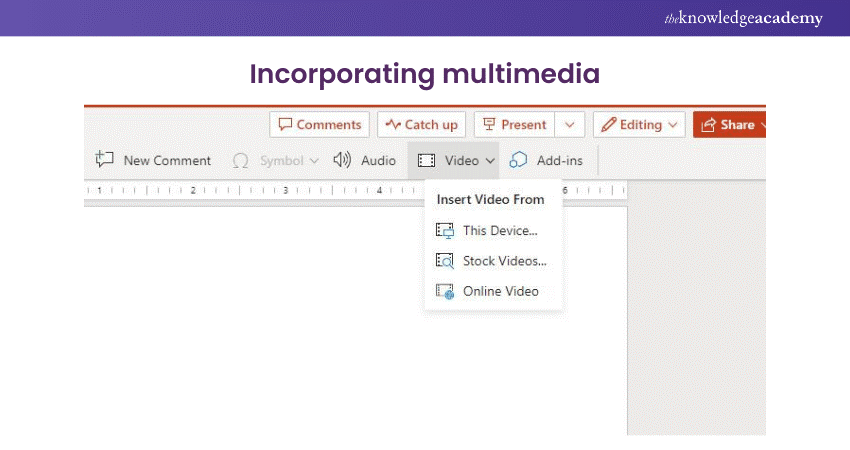
SmartArt and shapes
Learning How to Use PowerPoint means you can enjoy creative freedom. This platform offers SmartArt graphics and shapes that allow you to represent concepts, processes, and relationships visually. To insert SmartArt, you can do the following:
a) Go to the "Insert" tab
b) Click on the "SmartArt" button
c) Choose the desired SmartArt graphic and enter your text
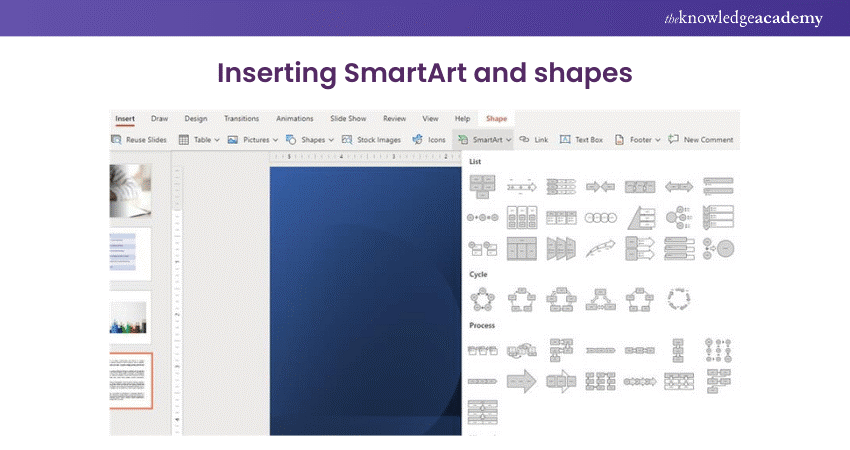
It also provides a variety of shapes that you can insert and customise. Shapes are useful for creating diagrams, highlighting key points, or adding decorative elements to your slides.
Apply themes and templates
Themes and templates offer a quick and easy way to give your presentation a professional and cohesive look. PowerPoint provides a wide range of pre-designed themes and templates to choose from. You just need to follow these steps:
a) Go to the "Design" tab in the Ribbon
b) Explore the available options
c) Select a theme that aligns with your content and enhances its visual impact
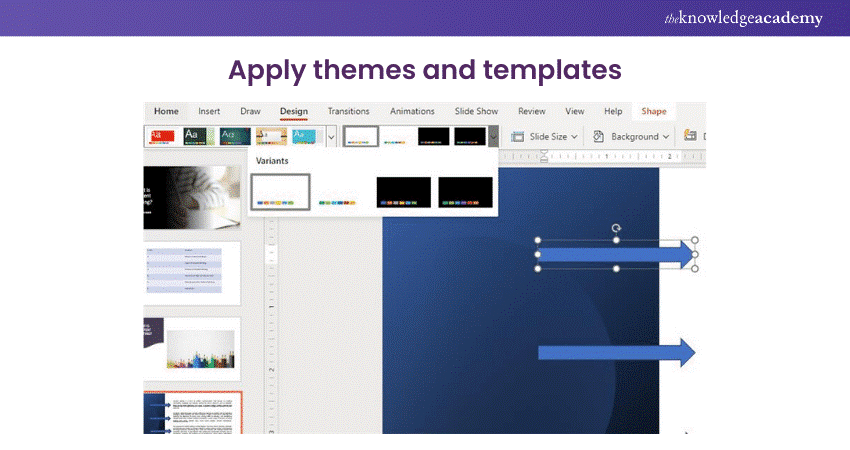
Templates provide pre-designed slide layouts that you can customise to suit your needs, saving you time and effort.
Add transitions and animations
Transitions and animations can add a dynamic element to your presentation, making it more visually appealing and engaging. To apply transitions between slides, you can do the following:
a) Go to the "Transitions" tab in the ribbon
c) Choose from a variety of transition effects
c) Customise their duration and timing
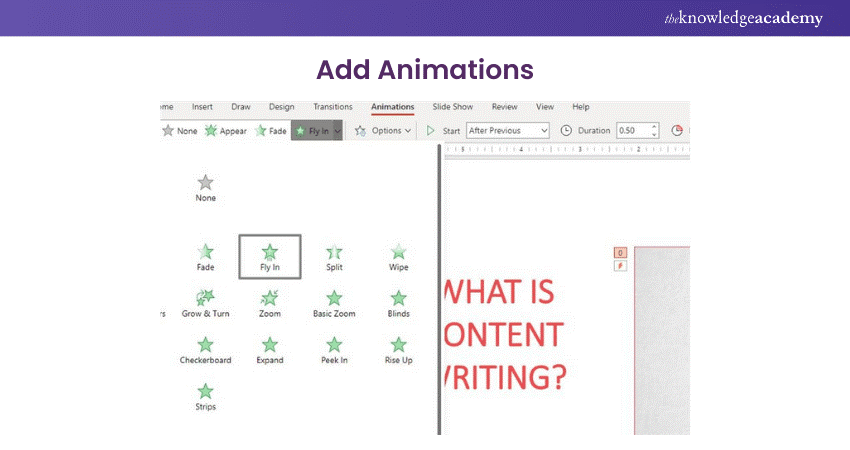
Animations, on the other hand, bring individual elements on your slides to life. Use animations strategically to highlight key points or reveal content captivatingly. You can access the “Animations” tab to explore the animation effects and available settings. The animations section looks something like the following image:
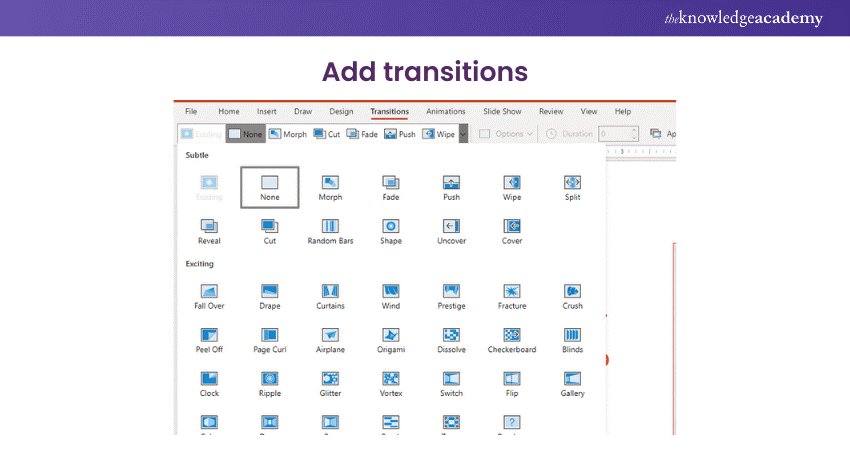
Enhance your Microsoft Office expertise - sign up now for Microsoft Office Training.
Tips and tricks for a great presentation
Delivering a great presentation requires careful planning, effective communication, and the ability to engage your audience. Read the following PowerPoint Tips and tricks that will help you create an impactful and memorable presentation:
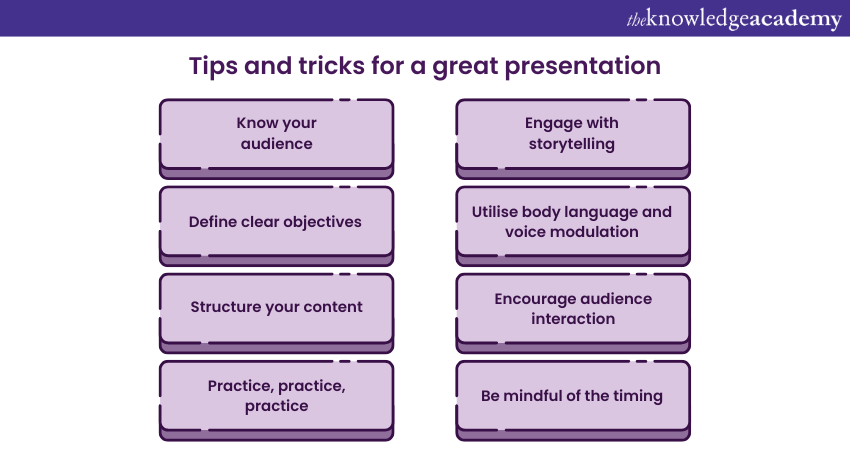
1) Know your audience
Understanding your audience is essential for tailoring your presentation to their needs and interests. Research their background, knowledge level, and expectations. This knowledge will enable you to adapt your content, language, and examples to resonate with them effectively.
2) Define clear objectives
What do you want your audience to learn, feel, or do as a result of your presentation? Setting specific goals will help you structure your content and guide your delivery. Keep your objectives in mind throughout the presentation to stay focused and achieve the desired outcomes.
3) Structure your content
Start with an introduction that grabs the audience's attention and provides an overview of what you'll cover. Further, divide your presentation into sections or key points, using clear transitions between them. Finish with a memorable conclusion that reinforces your main message and leaves a lasting impression.
4) Practice, practice, practice
Rehearse your presentation multiple times to build confidence and familiarise yourself with the content. Practice speaking clearly, maintaining a good pace, and using appropriate intonation. Time yourself to ensure that you stay within the allotted timeframe.
5) Engage with storytelling
Weaving storytelling elements into your presentation can captivate your audience and make your message more memorable. Use anecdotes, personal experiences, or case studies to illustrate key points or demonstrate the real-life applications of your topic. Storytelling creates an emotional connection with the audience and helps them relate to the information you share.
6) Utilise body language and voice modulation
Non-verbal communication is a powerful tool for engaging your audience. Maintain good posture, make eye contact, and use natural gestures to emphasise key points. Vary your vocal tone and volume to convey enthusiasm, emphasis, and emotions. A confident and expressive delivery enhances credibility and helps maintain your audience’s interest.
7) Encourage audience interaction
Ask thought-provoking questions, conduct polls, or engage in brief discussions. This involvement keeps your audience engaged, fosters active learning, and allows for different perspectives and insights. Encouraging questions and feedback also demonstrate that you value your audience’s input.
8) Be mindful of the timing
Respect your audience's time by keeping your presentation within the allocated timeframe. Plan your content and delivery to ensure you don't rush through or exceed the time limit. Practice pacing your speech, allowing for pauses and transitions.
Conclusion
We hope that you have gained a comprehensive understanding of How to Use PowerPoint. It’s time to put your knowledge into action. Start creating your own presentations, apply the tips and techniques given in this blog, and strive to improve your skills continuously.
Level up your Microsoft SharePoint Training with our Masterclass. Sign up now and become an expert SharePoint end-user.
Frequently Asked Questions

PowerPoint is basically used for creating visual presentations, allowing users to compile text and images to communicate ideas and information effectively in a slideshow format.

Feature like clear and concise content, visually appealing design elements, consistent formatting and appropriate use of images and graphics make PowerPoint look professional. Also, these elements collectively contribute to a polished and impactful presentation.

The Knowledge Academy takes global learning to new heights, offering over 30,000 online courses across 490+ locations in 220 countries. This expansive reach ensures accessibility and convenience for learners worldwide.
Alongside our diverse Online Course Catalogue, encompassing 17 major categories, we go the extra mile by providing a plethora of free educational Online Resources like News updates, Blogs, videos, webinars, and interview questions. Tailoring learning experiences further, professionals can maximise value with customisable Course Bundles of TKA.

The Knowledge Academy’s Knowledge Pass, a prepaid voucher, adds another layer of flexibility, allowing course bookings over a 12-month period. Join us on a journey where education knows no bounds.

The Knowledge Academy offers various Microsoft Office Training, including Microsoft PowerPoint Training, Microsoft SharePoint Training, Microsoft Office 365 Training and Microsoft Access Training. These courses cater to different skill levels, providing comprehensive insights into Excel for Accounting.
Our Office Applications Blogs cover a range of topics related to PowerPoint, offering valuable resources, best practices, and industry insights. Whether you are a beginner or looking to advance your Microsoft Office skills, The Knowledge Academy's diverse courses and informative blogs have you covered.
Upcoming Office Applications Resources Batches & Dates
Date
 Microsoft PowerPoint Training
Microsoft PowerPoint Training
Thu 6th Jun 2024
Thu 4th Jul 2024
Thu 8th Aug 2024
Thu 5th Sep 2024
Thu 10th Oct 2024
Thu 7th Nov 2024
Thu 5th Dec 2024







 Top Rated Course
Top Rated Course



 If you wish to make any changes to your course, please
If you wish to make any changes to your course, please


